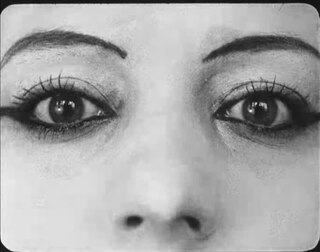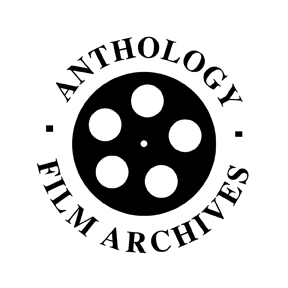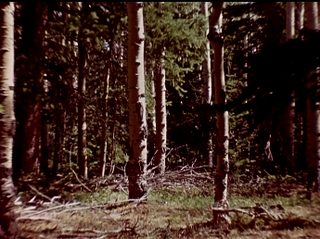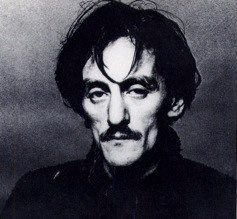
James Stanley Brakhage was an American filmmaker. He is considered to be one of the most important figures in 20th-century experimental film.
An underground film is a film that is out of the mainstream either in its style, genre or financing.

Scorpio Rising is a 1963 American experimental short film shot, edited, co-written and directed by Kenneth Anger, and starring Bruce Byron as Scorpio. Loosely structured around a prominent soundtrack of 1960s pop music, it follows a group of bikers preparing for a night out.

Experimental film or avant-garde cinema is a mode of filmmaking that rigorously re-evaluates cinematic conventions and explores non-narrative forms or alternatives to traditional narratives or methods of working. Many experimental films, particularly early ones, relate to arts in other disciplines: painting, dance, literature and poetry, or arise from research and development of new technical resources.

Lawrence Jordan is an American independent filmmaker who is most widely known for his animated collage films. He was a founding member of the Canyon Cinema Cooperative and the Camera Obscura Film Society.

Anthology Film Archives is an international center for the preservation, study, and exhibition of film and video, with a particular focus on independent, experimental, and avant-garde cinema. The film archive and theater is located at 32 Second Avenue on the southeast corner of East 2nd Street, in a New York City historic district in the East Village neighborhood of Manhattan.

Wavelength is a 1967 Canadian-American short subject by experimental filmmaker and artist Michael Snow. Considered a landmark of avant-garde cinema, it was filmed over one week in December 1966 and edited in 1967, and is an example of what film theorist P. Adams Sitney describes as "structural film", calling Snow "the dean of structural filmmakers."

At Land is a 1944 American experimental silent short film written, directed by, and starring Maya Deren. It has a dream-like narrative in which a woman, played by Deren, is washed up on a beach and goes on a strange journey encountering other people and other versions of herself. Deren once said that the film is about the struggle to maintain one's personal identity.

Zorns Lemma is a 1970 American structural experimental film by Hollis Frampton. Originally starting as a series of photographs, the non-narrative film is structured around a 24-letter classical Latin alphabet. It remains, along with Michael Snow's Wavelength and Tony Conrad's The Flicker, one of the best known examples of structural filmmaking.
Cosmic Ray is a 1962 American experimental short film directed by Bruce Conner. With both found footage and original material, it features images of countdown leader, a nude woman dancing, a Mickey Mouse cartoon, and military exercises. It is soundtracked by a performance of Ray Charles's "What'd I Say" and has been recognized as the first music video.
The Millennium Film Workshop is a non-profit media arts center located in New York City. It is dedicated to the exhibition, study, and practice of avant-garde and experimental cinema. It was also where the St. Mark's Poetry Project began. Ken Jacobs stated in 2013 that he chose the name Millennium "...because it would have to be that to actually give out equipment, education, space to work in, etc. for free. Dictionary definition: 'A hoped for period of joy, serenity, prosperity and justice.' "

The Wold Shadow is an experimental short film by Stan Brakhage, produced in 1972.
American artist Joseph Cornell (1903–1972) is justifiably best known for his boxes which constitute a singular contribution to the Surrealist canon and to the art of assemblage. However, he also pursued experimental film-making as an amateur beginning in the 1930s. Cornell was the principal pioneer of collage films in a purely artistic sense and, although the introduction of his films into the public forum was relatively late compared to when they were made, his work as a filmmaker has been widely influential.

Massimo Bacigalupo is an experimental filmmaker, scholar, and translator of poetry, essayist and literary critic. He was a founding member of the Cooperative of Independent Filmmakers in Rome. As a filmmaker of the Italian Independent Cinema, he was influenced by the New American Cinema.

Jerry Jofen (1925–1993) was an American painter, collagist, and experimental filmmaker.
The End is a 1953 American short film directed by Christopher Maclaine. It tells the stories of six people on the last day of their lives. It premiered at the San Francisco Museum of Modern Art as part of Frank Stauffacher's Art in Cinema series. Though the film met audience disapproval at its premiere, it was praised by critics as a "masterpiece" and "a great work of art".

Cave Girls is a 1984 New York No Wave underground film by Kiki Smith created on Super 8 between 1981 and 1984. that makes use of Stan Brakhage-like montage cutting.
Anticipation of the Night is a 1958 American avant-garde film directed by Stan Brakhage. It was a breakthrough in the development of the lyrical style Brakhage used in his later films.
The Way to Shadow Garden is a 1955 American experimental film directed by Stan Brakhage.
Sirius Remembered is a 1959 American experimental short film directed by Stan Brakhage. It captures the gradual decomposition of the corpse of Sirius, the Brakhage family's dog, over the course of several months.












